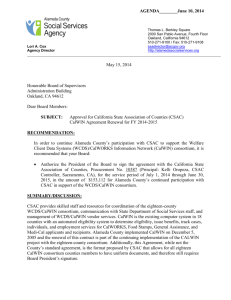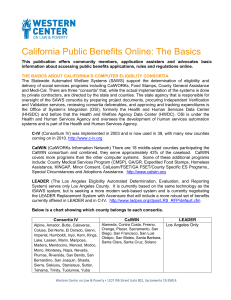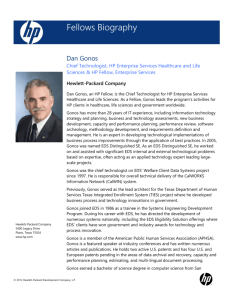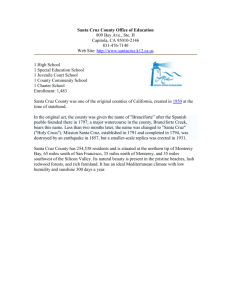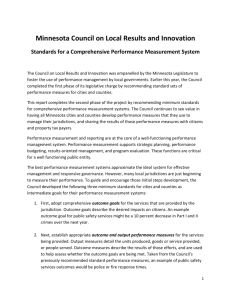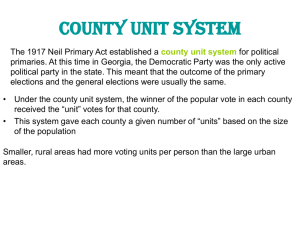44.
advertisement
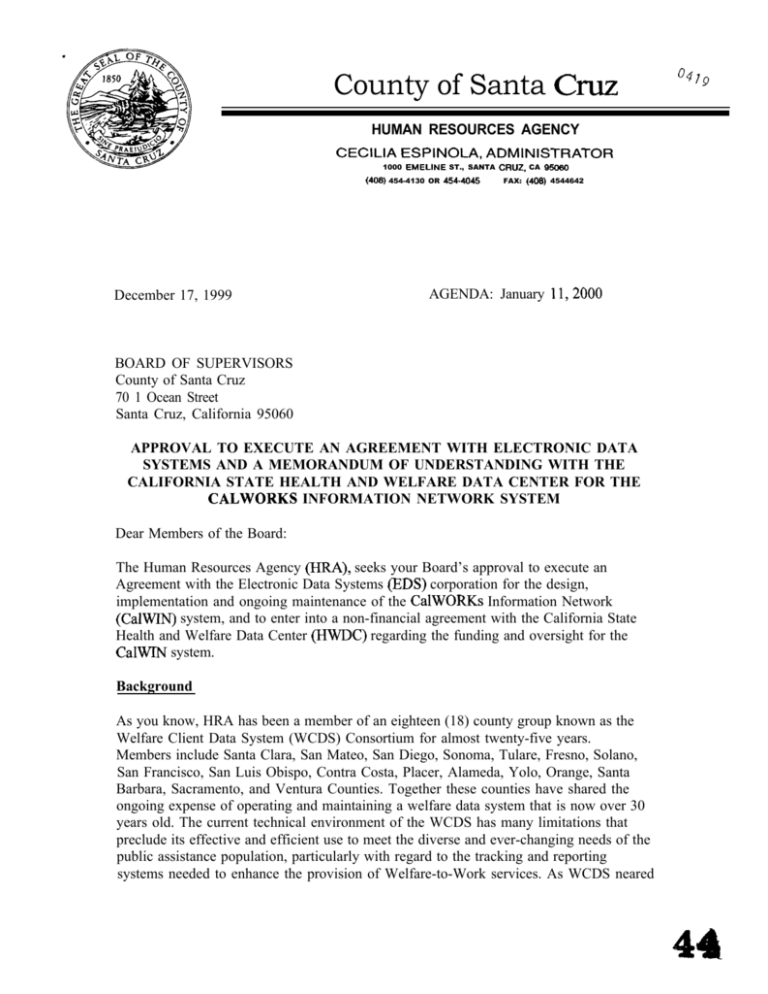
County of Santa Cruz 0419 HUMAN RESOURCES AGENCY CECILIA ESPINOLA, ADMINISTRATOR 1000 EMELINE ST., SANTA CRUZ, CA 95060 (408) 454-4130 OR 454-4045 December 17, 1999 FAX: (408) 4544642 AGENDA: January 11,200O BOARD OF SUPERVISORS County of Santa Cruz 70 1 Ocean Street Santa Cruz, California 95060 APPROVAL TO EXECUTE AN AGREEMENT WITH ELECTRONIC DATA SYSTEMS AND A MEMORANDUM OF UNDERSTANDING WITH THE CALIFORNIA STATE HEALTH AND WELFARE DATA CENTER FOR THE CALWORKS INFORMATION NETWORK SYSTEM Dear Members of the Board: The Human Resources Agency (HRA), seeks your Board’s approval to execute an Agreement with the Electronic Data Systems (EDS) corporation for the design, implementation and ongoing maintenance of the CalWORKs Information Network (CalWIN) system, and to enter into a non-financial agreement with the California State Health and Welfare Data Center (HWDC) regarding the funding and oversight for the CalWTN system. Background As you know, HRA has been a member of an eighteen (18) county group known as the Welfare Client Data System (WCDS) Consortium for almost twenty-five years. Members include Santa Clara, San Mateo, San Diego, Sonoma, Tulare, Fresno, Solano, San Francisco, San Luis Obispo, Contra Costa, Placer, Alameda, Yolo, Orange, Santa Barbara, Sacramento, and Ventura Counties. Together these counties have shared the ongoing expense of operating and maintaining a welfare data system that is now over 30 years old. The current technical environment of the WCDS has many limitations that preclude its effective and efficient use to meet the diverse and ever-changing needs of the public assistance population, particularly with regard to the tracking and reporting systems needed to enhance the provision of Welfare-to-Work services. As WCDS neared 44 ’ ’ BOARD OF SUPERVISORS Agenda: January 11,200O AUTHORIZATION TO EXECUTE AGREEMENT AND MEMORANDUM OF UNDERSTANDING 2 obsolescence it was determined that the cost and effort to upgrade this system to meet new federal and state requirements for automation was not a viable option. Under a federal mandate to create an automated statewide system that would manage the demands of increasingly complex public assistance programs, the California Department of Social Services initiated the Statewide Automated Welfare System (SAWS) Project. Language in the State Budget for 1995/96 gave the 58 counties the responsibility for development and implementation of a service delivery level welfare system with the requirement that they form consortia to facilitate the task. The WCDS Consortium has undertaken the task of developing and implementing an entirely new and fully automated system to meet both current and projected demands of California’s public assistance client population. This new mandated system is known as the CalWORKs Information Network (CalWIN). Together the Consortium issued an Invitation to Partner, received an acceptable proposal t?om the EDS Corporation and their partners, Deloitte Consulting and Unisys Corporation, and have recently negotiated an agreement with the vendor. CalWIN Features CalWIN will determine client eligibility, calculate benefits, exchange information with other welfare-related systems and provide extensive management reporting capabilities for the CalWORKs, Adoptions Assistance, Refugee Assistance, Child Care, General Assistance, Food Stamp, Medi-Cal, Welfare-To-Work and Cal-Learn programs. It will be: A single integrated system that will replace approximately sixty (60) separate systems currently used by the WCDS Consortium to meet welfare services, reporting and operational needs. Integration will eliminate redundant worker and client processes as well as overlapping maintenance and operations support services inherent in these multiple systems. Client-based, unlike WCDS, which is case-based. Many program and policy changes impact eligibility at the individual level, and because WCDS is a casebased system labor intensive case-by-case reviews are needed to identify both individuals and cases which may be affected by such changes. In CalWIN, client data will be unique to the individual rather than the case. The data can be examined without duplication of effort as the individual moves into, out of, and between various assistance programs. This is an especially important feature in supporting our CalWORKs clients as they move between all the programs designed to support their goal of achieving self-sufficiency. On-line & Real-time eligibility determinations and benefit calculations will provide the caseworker with the means to more accurately assess the clients 44 O420 - - BOARD OF SUPERVISORS Agenda: January 11,200O AUTHORIZATION TO EXECUTE AGREEMENT AND MEMORANDUM OF UNDERSTANDING 3 O42J needs and match those to the appropriate and available services and benefits. Electronic data storage and on-line retrieval will decrease the need for physical storage space and reduce paper usage. Modular in design, utilizing table logic for maximum flexibility and ease of updating to accommodate County-specific CalWORKs plans and requirements. Twenty-six (26) functional modules will address business process needs and support tools, with counties able to control the order in which functions are performed and by whom. Easy to use, with the complex codes used in WCDS replaced by a Windows-type Graphical User Interface which combines ml1 text field labels with drop-down choice menus, checkboxes, automated documentation, extensive on-line help including policy, procedure and regulation manuals, and real-time editing and updates. Designed to support effkient business practices. Automated eligibility determination., benefit calculation, noticing and interfaces to partner agency systems will increase the consistency, accuracy and speed of service delivery. Comprehensive reporting and ad-hoc features will provide accurate and real-time information for program assessments and management decisions, as well as for responses to requests for information fi-om appropriate government and community agencies. CalWIN Technical Aspects CalWIN will utilize multi-tiered client/server architecture. The system environment will provide consolidated databases run by EDS at a central data processing site in the Sacramento area with Wide Area Network (WAN) connectivity to each county. All of the various user sites within the county will use the local County WAN to access the system. A primary Consortium requirement is that CalWIN be co-existent with other County systems. System security, from full data encryption to equipment redundancy, reliability, and back-up contingencies, are also priorities of CalWIN=s requirements. Santa Cruz County’s Information Services Department (ISD) has been actively involved during the planning and procurement phases of the CalWIN project to assure that the system will meet all federal, state and county hardware and system requirements, as well as adherence to County protocols. Both HRA and ISD technical staff have reviewed the proposal and provided input to HRA” s CalWIN Planning Manager to clearly define what is needed and what is being proposed. This included a thorough review of the specific hardware and development software as well as the approach to system architecture considerations network sizing, scalability, testing, system management and maintenance. A quality assurance vendor hired by the Consortium as well as oversight by state HWDC 44 - - BOARD OF SUPERVISORS Agenda: January 11,200O AUTHORIZATION TO EXECUTE AGREEMENT AND MEMORANDUM OF UNDERSTANDING 4 staff are in place to ensure the vendor’s compliance with all aspects of the CalWIN design and operation requirements. CalWIN Application Development & Implementation While EDS has already assembled most of its project team and is in the process of acquiring its CalWIN Project site, the official timeline calls for a start date no later than February 28th, 2000. Total time for design, development and implementation of CalWIN in all WCDS counties is scheduled to take 5 1 months. HRA staff will be participating in Joint Application Design (JAD) sessions over the next 12 months to ensure that CalWIN meets HRA’ s needs, as well as to incorporate design elements that are needed in order for CalWIN to interface properly with other agencies with whom I-IRA shares clients and processes. Drug & Alcohol, Mental Health, Auditor-Controller, General Services, Health Services, Probation, Treasurer-Tax Collector, County Office of Education and Family Support are among the many partners with whom HRA will be working to ensure that their staff, client and program needs are represented in the development of CalWIN. There will be two pilot counties, with Sacramento piloting CalWIN to test its largecounty capabilities and either Yolo or Placer doing the same to check its operation in a small county. All hardware and WAN and LAN connections are to be installed six months e to implementation to allow for system testing and access to CalWIN’s module for computer-based and interactive staff training. Consortium implementation strategy calls for bringing up no more than one county per month to ensure maximum efficiency in use of training facilities, support staff and other needed resources, Santa Cruz County HRA is currently scheduled to implement in fall of 2002. Risk Assessment & Cost The CalWIN project has undertaken a number of steps to minimize and mitigate risk. The attached Memorandum of Understanding (MOU) with the state Health and Welfare Data Center (HWDC) establishes the maximum amount of charges payable by the Counties. It allows counties to terminate the agreement with EDS in the event that state and federal approvals/funding are withdrawn, provides additional technical oversight for project development and testing, and allows Counties to receive advances for most Agreement deliverables. The Consortium has retained the services of Renaissance Government Solutions (RGS); the same vendor used for the Planning and Procurement stages of this project as its primary Quality Assurance vendor. Given that RGS wrote the original Invitation to Partner they have a solid understanding of what the Consortium expects from the CalWIN system, both in terms of its design and reliability. The State Department of Information Technology (DOIT) will be working with HWDC to provide another layer of oversight on the project. An on-site Consortium CalWIN Project Team made up of program and technical staff from the member counties will be working with the vendor (EDS) at their office on a day-to-day basis during development and implementation. This will provide a practical end-user focus, as well as to provide the ‘44 O422 . BOARD OF SUPERVISORS Agenda: January 11,200O AUTHORIZATION TO EXECUTE AGREEMENT AND MEMORANDUM OF UNDERSTANDING 5 O42j Consortium with early alerts on issues so a swift response from the Consortium can avert potential delays. Two independent consulting firms hired by DOIT have reviewed the EDS Agreement and have determined the costs and timelines to be reasonable, and Consortium has had the Agreement reviewed for legal integrity by attorney Rich Wyde of Davis, Wright, Tremaine LLP. Mr. Wyde is regarded as one of the country’s leading authorities in the area of computer licensing, intellectual property and telecommunications law. The Agreement requires that EDS establish a letter of credit in the amount of $10 million, which the Counties may use to compensate themselves in the event of termination of the Agreement due to breach by EDS. It requires EDS to provide a $10 million performance bond, and provides for liquidated damages to the Counties. It allows Counties to seek actual damages in the event that they are greater than the liquidated damages and Gives Counties the right to terminate the Agreement if EDS does not cure a material breach within 30 days. Santa Cruz County Counsel has also reviewed both the Agreement with EDS and the non-financial MOU with HWDC and have approved as to form. Because of the federal mandate for California to develop a fully automated public assistance system, enhanced funding has been made available which tremendously reduces the county share of cost for the CalWIN project. The total cost of the 99 month long project (5 1 months for design and implementation and an additional 48 months of operation and maintenance) for the eighteen (18) WCDS counties is $471,582,024.00. The CalWIN cost for Santa Cruz County is $7,374,598.00. Of this amount, the county share is projected to be slightly less than 8%. With regard to the EDS Agreement itself, Santa Cruz County’s share of cost over the 99-month term of the contract is projected at $354,5 10. This includes the cost of components for the General Assistance (GA) program. During the first 51 months of the project the Counties are responsible for 5% of the Application Development costs and all expenses related to the CalWIN components of the GA program. Items such as computer equipment, hardware, site preparation and training are expected to be 100% funded. Once we enter the maintenance and operations period (the last 48 months of the 99-month Agreement), state and federal participation will be at normal sharing ratios of the programs that will share in the cost. In aggregate, this is typically 11% until such time as we reach our maintenance of effort (MOE). Given the timefiame for the vendor to complete their project site we do not anticipate any county share of costs for this fiscal year. HRA anticipates that it will receive a final allocation for the CalWIN project within the next few months, and will incorporate those costs and revenue in next year’s budget. As of this writing fifteen (15) WCDS counties have already received approval from their Boards of Supervisors, and it is anticipated that another two counties will have signed on for participation by the date this request is before your Board. t 44 mBOARD OF SUPERVISORS 6 Agenda:. JA~A~T 1-1, ‘%&XI AUTHORIZATION TO EXECUTE AGREEMENT AND MEMORANDUM OF UNDERSTANDING IT IS THEREFORE RECOMMENDED that your Board: 1. Authorize the Human Resources Agency Administrator to execute the attached Agreement with EDS; and 2. Authorize the Human Resources Agency Administrator to sign the attached nonfinancial Memorandum of Understanding with the state Health and Welfare Data Center. Very Truly Yours, . tt!Abbm L!pM”‘k CECILIA ESPINOLA Human Resources Administrator CE\ES RECOMMENDED: \ / SUSAN A. MAURIELLO County Administrative Officer CC: County Administrative Office Auditor Controller Information Services Department HRA-Fiscal General Services 44 O4‘?4
